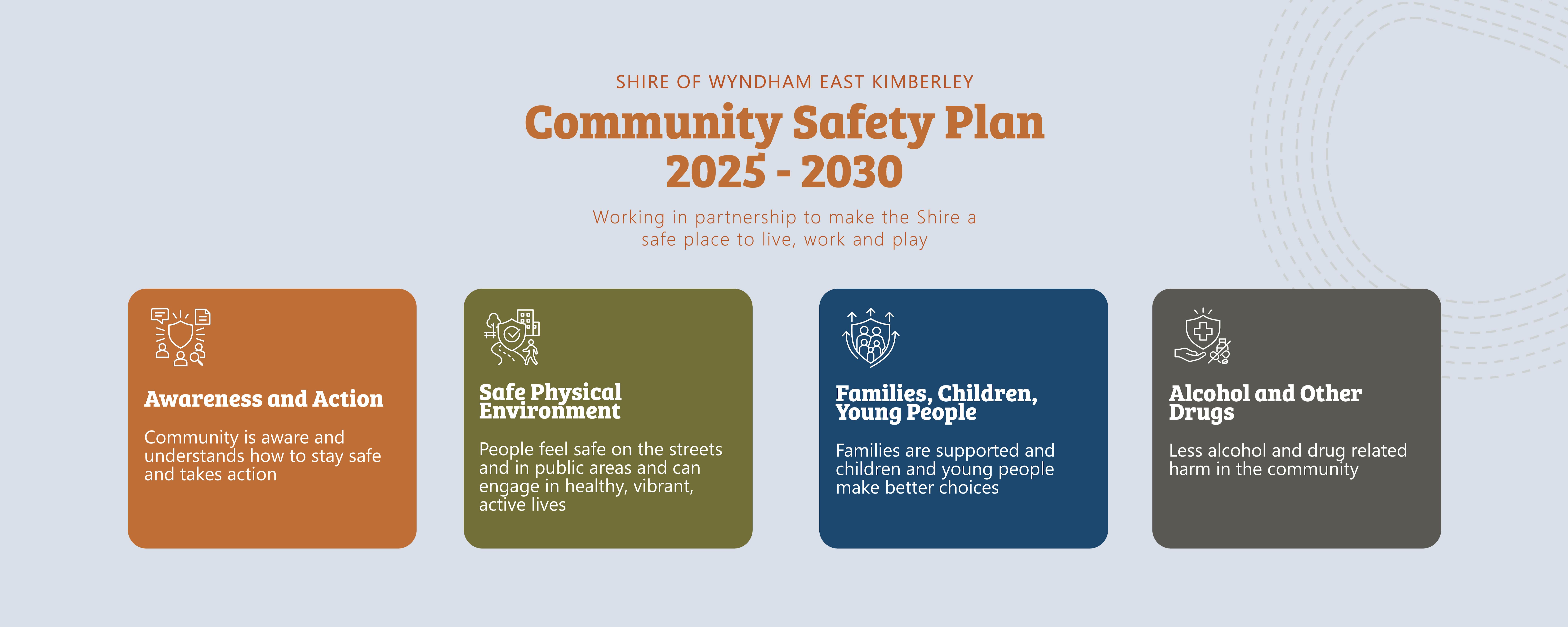Community Safety Plan
The Shire has developed a draft Community Safety Plan to align with the Shire’s Strategic Community Plan and reflects the community’s vision of creating a more liveable, connected, and sustainable future. The Shire now invites the community to review and comment on the draft plan.
The plan is structured around four key outcomes:
1. Awareness and Action: Empowering the community through education and participation to enhance safety awareness and proactive behaviour.
2. Safe Physical Environment: Designing public spaces to reduce crime and foster vibrant, active community life.
3. Families, Children, and Young People: Supporting families and youth to break cycles of disadvantage and promote positive choices.
4. Alcohol and Other Drugs: Reducing harm caused by alcohol and drug misuse through advocacy and support services.
Alignment to the Strategic Community Plan
1. Awareness and Action: Empowering the community through education and participation to enhance safety awareness and proactive behaviour.
Awareness and education are critical to building a safe and resilient community. When people understand risks, know how to respond, and feel empowered to take action, they are better equipped to protect themselves and others. From personal safety and emergency preparedness to road safety, knowledge and confidence can significantly reduce both actual harm and the fear of harm.
Why this matters for community safety
A community that is informed and engaged can prevent risks before they occur, respond effectively in emergencies, and support one another in times of need. Increasing awareness also builds community confidence, reduces anxiety, and fosters a culture of shared responsibility for safety.
2. Safe Physical Environment: Designing public spaces to reduce crime and foster vibrant, active community life.
The design of towns, neighbourhoods and public spaces directly influences both the perception and reality of safety. Thoughtful planning can help prevent crime, reduce accidents and create inviting places where people feel comfortable connecting and participating in community life. In contrast, poor infrastructure or neglected areas can contribute to antisocial behaviour and increased vulnerability.
Why this matters for community safety
Creating a safe physical environment is central to building a liveable and connected community. When residents feel comfortable using public spaces, whether walking at night, attending events, or letting children play outdoors, social cohesion and trust are strengthened. This reduces isolation, increases natural surveillance, and lowers opportunities for crime.
3. Families, Children, and Young People: Supporting families and youth to break cycles of disadvantage and promote positive choices.
Many young people involved in crime have grown up in unstable environments marked by poor parenting, substance misuse, violence, poverty, and joblessness. While this doesn’t excuse criminal behaviour, it highlights opportunities to break the cycle of disadvantage. Research shows that the early years of a child’s life are critical. Supporting families and individuals during this period is the most effective way to influence long-term outcomes.
Why this matters for community safety
Investing in early intervention and education can reduce risk factors of young people engaging in antisocial and offending activity and promote positive outcomes for individuals and the wider community.
4. Alcohol and Other Drugs: Reducing harm caused by alcohol and drug misuse through advocacy and support services.
Alcohol and other drug (AOD) use is a major contributor to community safety issues, including family violence, road trauma, antisocial behaviour, property crime, and health emergencies. In regional and remote communities, the impacts can be intensified by limited access to support services, social isolation, and higher levels of disadvantage.
Why this matters for community safety
AOD-related harm affects the whole community. The social, economic, and cultural impacts are felt across families, workplaces, and public spaces. Reducing AOD-related harm is critical to improving both real and perceived safety in our community. This requires a balanced approach that combines prevention, early intervention, harm reduction, enforcement, and treatment.






